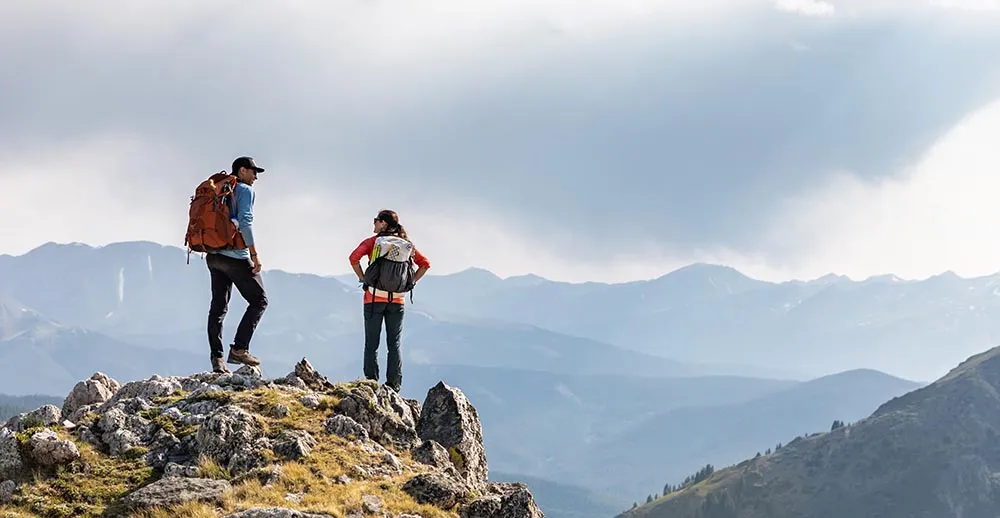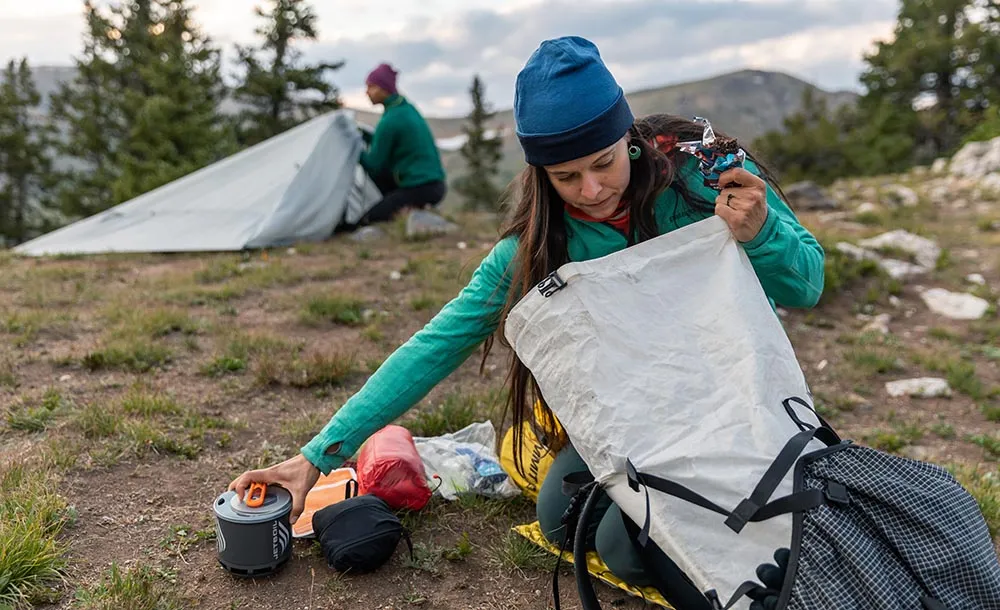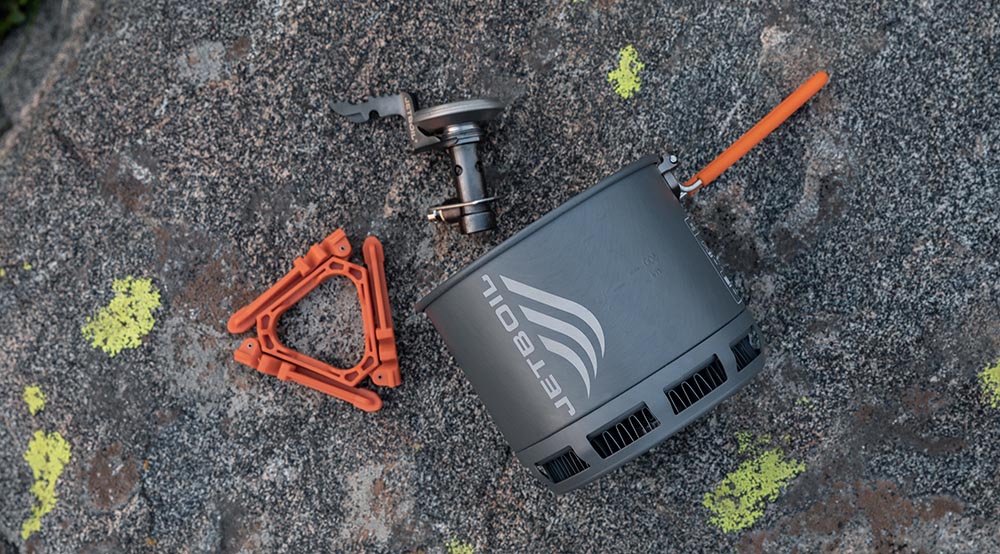Ultralight Backpacking Guide
For a long time, the average backpacker carried anywhere from 50 to 70 pounds of gear with them. As engineers push gear to be smaller, lighter, and more efficient, that number has gone down over time. A growing movement of backpackers has challenged the conventions of backpacking, combining new tech with new attitudes to get their pack weight as low as possible. These ultralight backpackers usually carry less than 30 pounds with them. Some go as low as 12, and the extreme ultralight trekkers can get theirs under 10. Getting your pack that light takes some time, creativity, and money, but your back will thank you on long treks.
For ultralight backpacking prep, every little bit of gear makes a difference. Weight-conscious campers can find backpacks made of composite fabrics and trekking poles made from carbon fiber. Equipment as basic as your tent stakes can be made from lightweight aluminum. Even footwear has made technological leaps. The average pair of hiking boots weigh around 3 ¾ pounds. Compare that to trail runners, which usually weigh about 1 1/3 pounds. Factor weight differences like that across all the gear you take with you, and those extra pounds add up in a hurry.

What is Ultralight Backpacking?
So what does ultralight mean? It means less gear and lighter gear. It means a pack that weighs around 12 to 24 pounds. It means learning to do more with less. Ultralight backpacking is marked by ingenuity and thoughtfulness.
Ultralight backpackers do it for more than bragging rights. Carrying less means that you can hike further in less time. You experience less wear and tear on your muscles and joints. You may find that your back doesn't seem to mind hiking as much. And since you're not working as hard, you may find that you can tackle longer trails and more challenging terrain.
Gear Considerations and Trade-offs
There are always trade-offs when considering gear. One of the biggest, most obvious ones you'll find is that ultralight backpacking gear tends to cost more, which makes sense. It takes a lot of engineering-and often some high-tech materials-to get a piece of gear's weight down.
When looking for ultralight gear, consider the quality and durability of the items you're thinking of buying. Some things are light because they've been carefully made that way. Some things are light because they're flimsy. Between something's price and the way it feels in your hands, you can usually tell if something's built to last or not.
Finally, comfort is a significant consideration. Some people are willing to sacrifice comfort in the name of shedding pack weight. For some people, that may mean sewing their own pack, with less padding and frame weight. Some ultralight backpacking enthusiasts will bring a pad that's only torso-length. Others will lose tent weight by using a tarp as a shelter instead. There's a line where carrying less means sparing some comfort. Some people enjoy crossing that line. But most hikers will find that they can lose a lot of pack weight before they get to those extremes.
Steps to Making an Ultralight Backpacking Kit
- Lay out all your gear in one place
- Analyze your gear while considering your trip, thinking about what you truly need
- Add what's necessary and subtract what's not
- Pack your backpack
- Wear your backpack to test
- Add or subtract again
- Wear your backpack again to test
- Weigh your backpack
- Go backpacking and note how the weight felt
As you evaluate your gear, look for places to cut weight. The big items for most people are their tent, backpack, sleeping bag, and sleeping pad. If you're replacing your gear with ultralight gear, you may want to start there. You don't have to replace all of your backpacking gear right away. Consider picking up a light, single-person tent and seeing what that does to your hikes before moving on to something else.
Ultralight is a process. Strategizing and adjusting is part of the fun. Over time, you'll find a sweet spot that keeps you at the level of comfort you want while easing the strain on your back without breaking the bank.

Ultralight Backpacking Gear Essentials
Backpack
Your backpack is a huge opportunity to shed weight. Since you're carrying less, you can get a smaller bag, and you don't even need a frame pack. Choosing a smaller bag with less padding and no frame can shave a 3-to-4 lb. load down to half that weight.
Shelter - Tent, Tarp, or Bivy
Your tent is another one of the biggest, heaviest items you carry. An ultralight mesh tent with a rain fly can weigh less than 3 lbs. Despite the low weight, it can still protect you from weather and bugs. Something like the SOLITAIRE AL can set up quickly and provide proper shelter without weighing you down.
Some people choose to lose the tent altogether in favor of alternative shelters. One popular option is a tarp, and you can even pick up specially-designed tarp shelters made for ultralight backpacking. Others opt for a combination setup of a hammock and a tarp, and you can buy hammocks that come with a tarp to set up over the hammock. Tarps weigh less than a tent and tend to be cheaper. They also often let you cook or make a fire while still having a shelter over your head, which you can't do in a tent. But there are downsides. Without a protective mesh, you'll be exposed to insects, and if you don't pitch it right (or conditions are bad enough), there's little protection from wind and rain. Tarps can also be harder to pitch and less stable than a tent.
A third option that many ultralight backpackers choose is a bivouac. (You may see people say "bivy" or "bivvy" for short.) A bivy is a small, waterproof shelter. Smaller than a personal tent, it's more like a windbreaker for your sleeping bag. The bivy sack wraps around your bag, adding an extra layer of protection and a hoop over your head. The hoop provides extra headroom and easier breathing, while the bag itself keeps out wind, rain, and bugs. A bivy is an incredibly light option and very easy to set up. But changing clothes can be difficult, and it's not for the claustrophobic. You can buy a standalone bivy sack or an ultralight one meant for use with a tarp.

Sleeping System
Choosing a sleeping bag for ultralight backpacking can be a challenge. It's essential to have a sleeping bag rated for the temperature you expect to camp in. However, the lower the temperature rating, the heavier the load, so you'll want to be sure to have the right sleeping bag for the trip. Using a bag that's overkill for where you're sleeping won't just mean a hot night. It'll mean carrying the unnecessary weight and using pack space you don't need to. Generally speaking, unless you're camping in extreme cold, you can find a sleeping bag rated for the temperature you need that weighs less than 3 pounds.
You may not want to bring a sleeping bag at all! Instead, many people try to keep their base weight down and opt for a wool blanket or an insulated outdoor quilt. Wool blankets have seen an upsurge in popularity alongside the ultralight camping movement. They may not offer the same waterproofing a sleeping bag does, but if you're in a tent, that may not matter. They provide an excellent ratio of warmth for weight.
Backpacking quilts are also a popular option. They're easy to vent if you're hot and can be used in a hammock or on the ground. For extreme cold, a sleeping bag is probably still your best bet. But in most cases, you may be able to trade it for something lighter and more versatile.
Consider other tricks to stay warm, as well. If your sleeping bag is a little cold for the weather you're in, you can add insulation by putting your warm clothing in the sleeping bag with you. That'll also help keep the next day's clothes warm before you even put them on!
Food
Anything that you carry for the entire duration of the trip is your "base weight." This includes your tent, sleeping bag, cooking gear, pack, and other essentials. But you also have to think about your consumables. Food and water can double a person's pack weight, so it's especially important to plan them carefully.
More complex meals will require more weight and space. Extra ingredients or specialized cooking gear can be a burden. One way to save weight is with "just add water" meals made from dry or dehydrated ingredients. Another is with a camp stove that's as light and as powerful as you can find. High-calorie, high-protein backpacking food like energy bars and trail mixes are great for eating on the go.
Cooking Gear
Your cooking gear should be as small and light as possible-but you'll still need to cook. A great workaround is an ultralight camping stove.
There are several fuel types to choose from with your camping stoves. Alcohol stoves are a popular option due to their weight, but they require you to carry a lot of fuel if you're planning on doing any serious cooking. A well-engineered propane stove like a Jetboil camping system gives you more control, power, and efficiency. That can save you a lot of weight on fuel.
Stash is Jetboil's solution for ultralight trekkers: a 7.1-ounce stove system with a 0.8-liter cook pot, burner assembly, and pour-lid all included. The entire system nests inside the pot for compact storage. Plus, the FluxRing technology means you boil twice as fast with half the fuel, meaning hikers can carry less weight in fuel. Gone are the days of cold-soaking and disappointing meals after long days on the trail. Stash allows the weight-conscious thru-hikers to bring a stove system without weighing down their pack.
If you don't opt for a unified cooking system, you'll need a small, lightweight pot to cook in and eat from. Be sure to factor that into your pack weight and space in addition to your camp stove. In any case, you'll also need some backpacking utensils. You shouldn't need much in the way of utensils, but you also don't want to be eating with your hands.

Water
Water is one of the biggest sources of added weight. As an ultralight hiker, you'll need to plan carefully based on the season, geography, and proximity to fresh water. You'll likely be purifying water on the go. This may involve pills, filters, boiling, or some combination thereof. Boiling in a lightweight camp stove is a great way to protect yourself from microorganisms, and Jetboil stoves are some of the lightest, fastest options for boiling water in a hurry. You may also want a filter to remove any particles or dirt. Gravity or squeeze filters are popular, lightweight options. Lightweight water bottles are available, but you may want to consider a bladder or bag that will shrink or expand as you fill it and empty it.
Essential Extras
Just because you're trimming gear doesn't mean you should skimp on safety. The 10 essentials are still essential. We've discussed some of these items already, but be sure to pack the rest:
- Navigation, including maps and a compass or a reliable GPS
- Multiple ways to start a fire such as matches and a handheld igniter
- First aid-even a basic kit for emergencies is better than nothing
- Emergency signaling tools like a flashlight, mirror, or whistle
- Hygiene items such as toothpaste and toothbrush
While it's not essential, you may also consider bringing something light for entertainment. A deck of cards doesn't take up much space or weight.
Reduce Weight and Eliminate Unnecessary Items
Now that you've got the basic idea behind ultralight backpacking, you can start working on trimming down your setup. The goal isn't to hit the trail with the lightest possible pack the first time around. You cut slowly and strategically, rather than risk ditching something that you need.
Go camping with the gear that you already have. (Or, at most, after replacing one piece of weighty gear with something lighter.) As you camp, think about what you use and what you don't. Seek out more lightweight gear or multipurpose gear that can replace several pieces of equipment with one.
After every trip, run through these steps:
- Review duplicate items
- Find items that have multiple uses--can you replace several items with a multi-tool? Will your hiking stick double as a pole for a lightweight tent or tarp? Can you cook and eat in the same container?
- Look for opportunities to buy lighter upgrades for primary items like your tent, backpack, and sleeping system. This can happen over time. Have fun with it! Do your research, and wait for sales. Upgrading your gear can be fun all on its own!
- After trips, list the items you didn't use. Some, like your first aid kit, should always be with you for safety's sake. But if any non-essentials didn't get used, consider not bringing them next time.
As time goes by, you can continually trim down your pack weight. You'll feel the difference on your back and shoulders. You'll likely cover more ground with greater ease. Not to mention that it feels pretty good to know you can have a good time with less in tow. Whether you're in it for easier toting, a boost in confidence, or love a challenge, ultralight backpacking has a lot to offer.






